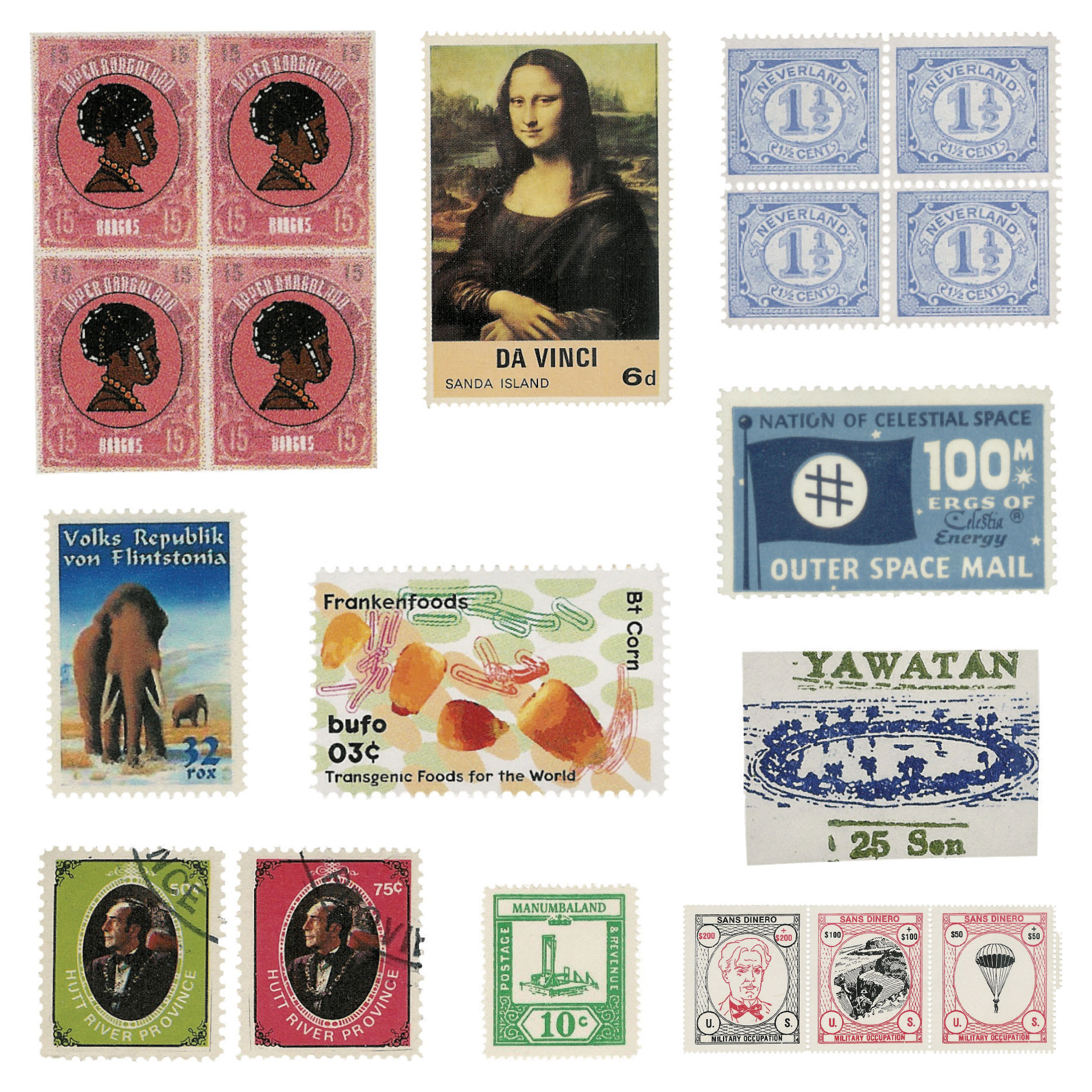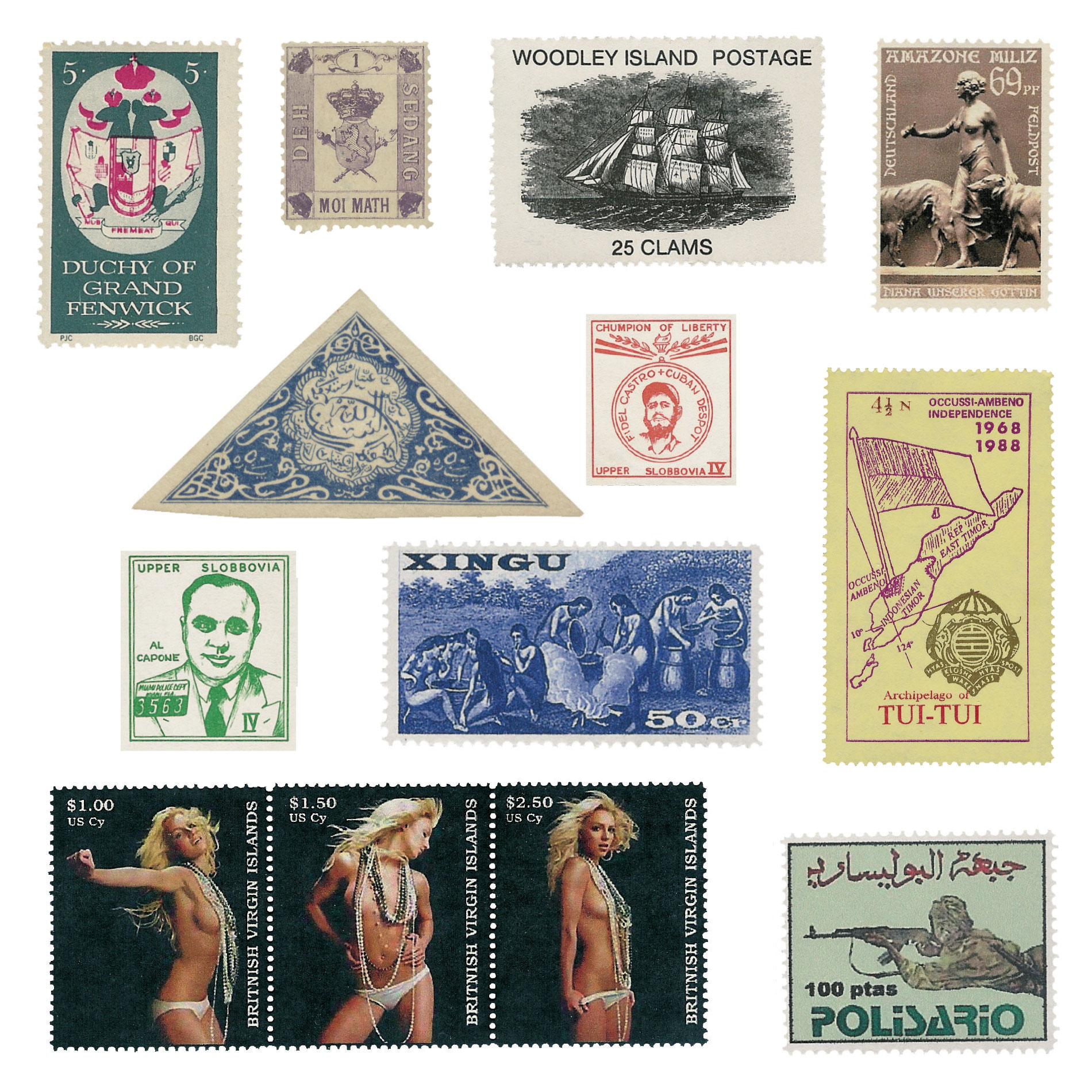Return to Sender
“Cinderellas,” the stepchildren of philately
Bonnie & Roger Riga

Ever since the first postage stamp was issued in May 1840 by Great Britain, there have been forged, bogus, and fantasy stamps. Forgeries are stamps that replicate actual postage for the purpose of defrauding the postal service or collectors; bogus stamps are fake stamps from real places, and fantasy stamps are imaginary stamps from non-existent places. These stamps, which don’t appear in the otherwise definitive Scott’s Catalogue, are collectively known as “Cinderellas”—they are the stepchildren of philately.
Fantasy stamps are most often intended as artistic, political, philosophical, or humorous statements. Advertisements for the 1959 movie The Mouse that Roared, in which the tiny Alpine Duchy of Grand Fenwick declares war on the US in anticipation of postwar financial aid after a hasty surrender, went out with a stamp from the fictional state. Beginning in 1961, the famous Wilkinsburg Stamp Club created Upper Slobbovia, issuing philatelic souvenir stamps for thirty years that spoofed regular US postage and current affairs. They depict unlikely American stamp subjects, such as Fidel Castro and Al Capone.
Often fantasy stamps depict satirical Utopias, such as the US Military Occupation of Sans Dinero, or the little island of Yawatan, an atoll in the South Pacific in the shape of a doughnut and perforated by a big lagoon, or Upper Bongoland. These stamps play on the notion of obscure “local posts,” which were created to carry mail from a remote place where official mail delivery did not serve, to the nearest post office or vice versa. Special stamps were made to supplement the regular stamps, to show an extra fee had been paid. However, many modern “local posts” really fall under the category of fantasy, because the service does not really exist. For example, Sanda Island, that has issued a Mona Lisa stamp, is a 314-acre island located two miles southeast of the Kintyre Peninsula in Scotland which has absolutely no need for mail, being exclusively occupied by birds and sheep. However, the stamps are profitable, and they appeal to many collectors.
Some fantasy stamps are overtly political, issued by militant groups to create an air of legitimacy for their imagined states. The POLISARIO stamp reproduced here refers to the Frente Popular de Liberación de Saguía el Hamra y Río de Oro, or the “People’s Liberation Front of Saguia el Hamra and Rio de Oro,” a guerilla army and political movement. Formed in 1973, and principally comprised of the Sahrawi people, the group was created to end the Spanish, Moroccan, and Mauritanian military administration of Western Sahara. In 1976, POLISARIO formally proclaimed the Sahrawi Arab Democratic Republic (SADR), a government in exile. Based in Tindouf, Algeria, it still contests the Western Sahara with Morocco, and controls the almost uninhabited part of the Western Sahara east of the “Moroccan Wall.”
Similarly, a group advocating the creation of a separate Zionist State of Judea created their own stamps. The issuers claim to have the support of Rabbi Meyer Kahane, former head of the ultra-rightist Kach party, whose stated goal was to drive all Arabs out of Israel (he was assassinated in New York City in 1990, by an Egyptian militant later convicted in relation to the 1993 World Trade Center bombing).
Other fantasy stamps are more lighthearted hoaxes. One German stamp depicts Princess Diana, honorary member and patroness of the Amazonian Militia, a loosely federated organization of female freedom fighters that reputedly has branches throughout the world. The organization claims to be seeking postal recognition similar to that granted to the Sovereign Military Order of Malta (SMOM), whose stamps are now considered valid in many countries throughout the world. Another “faux pas fantasy” strip shows the ruler of the newly liberated Britnish Virgin Islands, a scantily clad Britney Spears, demonstrating a native ritual fertility dance.
Today, with the ready availability of computer graphics and design and printing functions, nearly anyone can produce his or her own fantasy stamps. Thanks to twenty-first century technology, there has been a resurgence of interest in the genre. Cyber stamps are also a growing area of expression. There is something attractive about the concept of a stamp that has endured email and appeals to many people, not just the stamp collector.

Bonnie and Roger Riga are philatelists who specialize in “cinderella” stamps. Before forming their business, Rigastamps, in 1982, both had collected stamps since childhood. They sell items online at rigastamps.com and provide a free reference resource at www.cinderellas.info [link defunct—Eds.].
Spotted an error? Email us at corrections at cabinetmagazine dot org.
If you’ve enjoyed the free articles that we offer on our site, please consider subscribing to our nonprofit magazine. You get twelve online issues and unlimited access to all our archives.